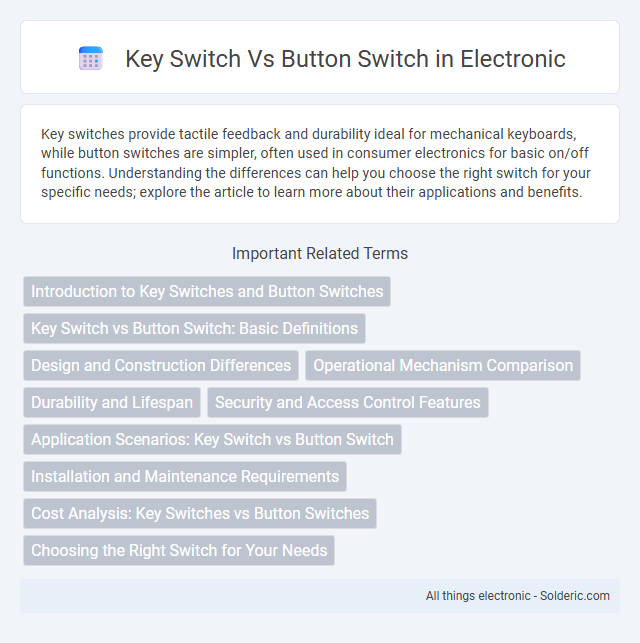Key switches provide tactile feedback and durability ideal for mechanical keyboards, while button switches are simpler, often used in consumer electronics for basic on/off functions. Understanding the differences can help you choose the right switch for your specific needs; explore the article to learn more about their applications and benefits.
Comparison Table
| Feature | Key Switch | Button Switch |
|---|---|---|
| Function | Mechanical switch activated by pressing a key | Simple switch activated by pressing a button |
| Use Case | Keyboard keys, mechanical keyboards, typewriters | Remote controls, doorbells, calculators |
| Design | Individual mechanical assembly with tactile feedback | Compact, often membrane or simple contact design |
| Durability | High durability (millions of actuations) | Medium durability (thousands to hundreds of thousands) |
| Feedback | Tactile and audible feedback | Usually no tactile feedback |
| Complexity | More complex, requires precise manufacturing | Simpler, easier to manufacture |
| Cost | Higher cost due to complexity and materials | Lower cost, commonly mass-produced |
| Common Materials | Metal springs, plastic housing | Plastic, rubber membranes |
Introduction to Key Switches and Button Switches
Key switches and button switches serve distinct roles in electronic interfaces, with key switches primarily used in keyboards to provide tactile feedback and precise actuation, while button switches are more common in general control panels for simple on/off functions. Key switches vary in types such as mechanical, membrane, and capacitive, each offering different durability and response characteristics, whereas button switches usually operate through simple pressure mechanisms. Understanding these differences helps you select the right switch type to optimize usability and performance in your device.
Key Switch vs Button Switch: Basic Definitions
A key switch is a mechanical or electronic switch activated by pressing a keycap, commonly used in keyboards for tactile feedback and durability. A button switch is a simple input device that completes or breaks an electrical circuit when pressed, often found in consumer electronics and machinery. Key switches prioritize precise actuation and user experience, while button switches emphasize straightforward on/off functionality.
Design and Construction Differences
Key switches feature mechanical components with individual actuators and springs beneath each keycap, providing tactile feedback and distinct actuation points, whereas button switches consist of a simpler membrane or dome mechanism designed for quick presses and minimal travel distance. The design of key switches supports durability and precise keystroke registration, making them ideal for keyboards requiring high responsiveness, while button switches emphasize compactness and cost-efficiency for devices with limited space. Your choice depends on the need for tactile feedback and longevity versus simplicity and affordability in switch construction.
Operational Mechanism Comparison
Key switches operate through mechanical or membrane mechanisms that register keystrokes when pressed, often providing tactile feedback, while button switches typically function via a simple electrical contact completing a circuit upon actuation. Key switches are designed for rapid, repeated activation with distinct actuation points, making them ideal for keyboards and precision input devices. In contrast, button switches prioritize straightforward on/off functions with less emphasis on tactile response, commonly used in control panels and household appliances.
Durability and Lifespan
Key switches typically offer greater durability and a longer lifespan compared to button switches, often rated for tens of millions of actuations due to their mechanical design. Button switches generally have a shorter lifespan, usually rated for a few hundred thousand to a couple of million presses, making them less ideal for heavy or prolonged use. Choosing key switches can enhance Your device's longevity, especially in high-traffic or intensive typing environments.
Security and Access Control Features
Key switches provide enhanced security through physical key control, restricting access to authorized personnel only by requiring a unique key to operate. Button switches typically lack integrated security features, making them vulnerable to unauthorized activation or tampering in access control systems. In critical applications, key switches are preferred for their robust protection against unauthorized access and potential security breaches.
Application Scenarios: Key Switch vs Button Switch
Key switches are widely used in computer keyboards, mechanical keypads, and industrial control panels due to their tactile feedback and durability. Button switches are common in consumer electronics, household appliances, and automotive controls where simple on/off functionality is required. Key switches excel in scenarios demanding precise input detection, while button switches are ideal for straightforward user commands and quick activation.
Installation and Maintenance Requirements
Key switches typically require more precise installation involving alignment and secure mounting, often demanding professional tools and expertise, while button switches are generally easier to install due to their simple push-fit or snap-in design. Maintenance for key switches involves occasional lubrication and careful inspection to ensure the mechanical parts function smoothly, whereas button switches mostly need basic cleaning to remove dust and debris for reliable operation. Choosing the right switch can significantly impact your maintenance routine, with button switches offering lower upkeep for most applications.
Cost Analysis: Key Switches vs Button Switches
Key switches generally have a higher unit cost compared to button switches due to their complex mechanical design and higher durability standards. Button switches are typically more cost-effective for large-scale production because of simpler construction and cheaper materials. When choosing between the two, project budget constraints and required switch lifespan significantly influence the cost-benefit ratio.
Choosing the Right Switch for Your Needs
Selecting the right switch depends on your application's requirements for tactile feedback, durability, and responsiveness. Key switches offer distinct tactile and auditory feedback ideal for typing and gaming, while button switches provide simpler, often quieter activation suitable for general-purpose electronics. Evaluating factors such as actuation force, travel distance, and environmental conditions ensures optimal performance and user experience.
key switch vs button switch Infographic

 solderic.com
solderic.com